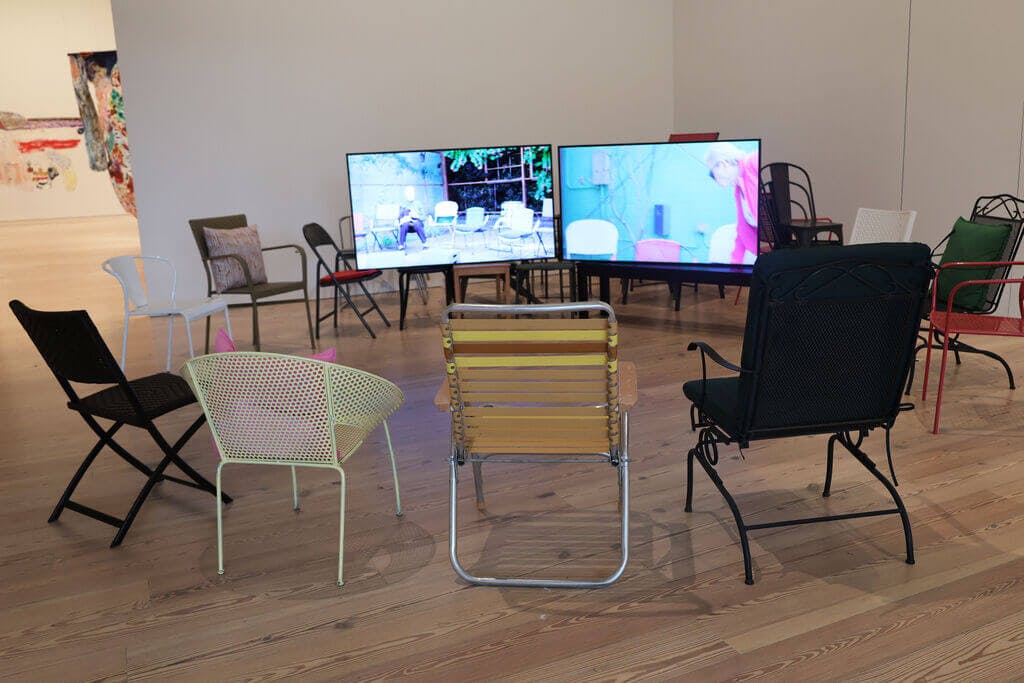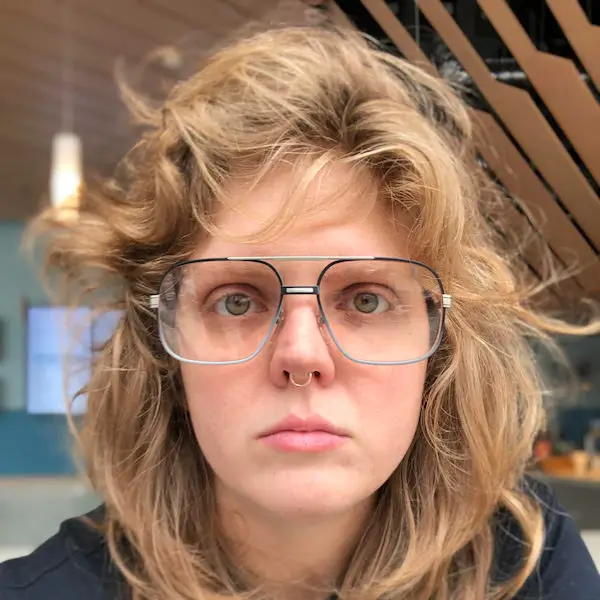As I enter this year’s Whitney Biennial, “Even Better Than the Real Thing,” I am met on the sixth floor by a large, citrus-toned installation ostensibly filled with electricity, which hums gently (yet threateningly) from a metallic grid hanging just above the walkable area of the room.
Leading with P. Staff’s room-sized installation Afferent Nerves feels apt. It gestures both toward the raw requirement/fact of technology’s being (electricity) and toward the circulatory system which defines this year’s Whitney Biennial: the circulation of the body and technology. Together, they form an intertwined portrait of the evolution of feminist ethics up until 2024—a vastly expanded and hybridized entity.
As a portrait, the biennial spans the breadth of age and contemporaneity, including both voices of gender expansivity which define our moment and the existence of more traditional versions of feminism—works which deal with maternity or breastfeeding by Julia Phillips, for example.
But more importantly, the show is defined by an ethic which is in the lineage of feminism, rather than “feminism” itself. It is, perhaps, a statement of evolution, a declaration of independence from that specific terminology which preceded it.
In the introductory wall text, curators Chrissie Iles and Meg Onli acknowledge the increasing rapidity with which gender and technological perspectives have shifted contemporary art cultures away from the terminology of “feminism,” while simultaneously retaining the ethos contained within that word.
Several artists in the exhibition were born in the 1940s. With this expansive range in artists’ ages, an undercurrent of historical feminisms interchange and feed back into the reality of our present technologically (en)gendered moment. This inclusive act simultaneously enacts a balancing act against ageism (again, a feminist ethic made “real”), but also includes voices of elders within that technological narrative.
As I take a small break during the event’s press preview, I notice Harmony Hammond observing her own work. At eighty years old, she is taking images with her smartphone and seems to be evaluating how the work and installation look as a small, digital artifact on her personal device.
This observation feels like a metaphor for sections of the show as a whole: a balance of the processes of the inherent “blur” of the analog hand versus the crisp digital color of today, the vast fidelity of the digital which far exceeds the eye or the hand. Perhaps this is one of the tongue-in-cheek questions behind the show’s title: Is the digital world “even better than the real thing” in terms of both fidelity and the increasing dystopia of our society’s devolution?
Throughout the exhibition, the act of digital making is overwhelmingly seen in the realm of video—video installations appear in primary spaces, corners, and nooks. While the exhibition text directly calls attention to artificial intelligence, the technology seldom rears its head in a concrete manner.
Almost all of these video works have their own dedicated rooms and many of them are over an hour long. Sharon Hayes’s return to the biennial is instead out in the open with a layout of two monitors set on improvised furniture-as-stands. Viewers are invited to sit on the lawn and kitchen chairs encircling the set up. The video monitors are arranged side by side, not unlike a book, and welcome audiences to watch the testimony of queer elders from different groups in Philadelphia, Tennessee, and Los Angeles, who are duly arranged in a circle that echoes the ones occupied by gallery visitors. If the two monitors function as the pages of a book, then the interviewer (Hayes herself) occupies the space of this book’s spine. We observe over her shoulder; she occasionally pops into frame. But the focus here is not on the artist; it’s on her interview subjects. Perhaps a thread to the biennial is that the act of listening to elders is a dying art.
Indeed, the acts of discovery found in this year’s biennial are not reserved for the emerging artist category, but rather for the established and the mature.
There is no section that better exemplifies that the act of listening is crucial than Suzanne Jackson’s limber paintings, which require no substrate. Whether hanging from the wall or suspended, these skins of pigment, found objects, and gel medium sing brilliantly in a way that says, “How did it take me so long to see this?”
If the sixth floor is a quiet series of questions, then the fifth floor is certainly louder, yet still questioning. From the vantage point of the elevators, visitors are greeted with Roxbury-born Tourmaline’s Pollinator, a seamless video loop ensconced in a cutout of the wall which evokes the floral; to enter the area would be to walk into the pistil.
The video component is a calming sort of dirge, as indicated by the intentionally accessible closed captioning, which includes descriptions such as “voices over ethereal music” and “low hum interspersed with chimes.” Archival footage associated with Marsha P. Johnson (an icon who is also monumentalized in Kiyan Williams’s aluminum sculpture Statue of Freedom (Marsha P. Johnson)) is interspersed with footage of Tourmaline herself: in a garden, in a forest, experiencing zero-gravity in an aircraft colloquially known around NASA as the “vomit comet,” or more accurately, a simulation of near-weightlessness.
Here, again, the question between the virtual and the actual becomes merged: as an analog simulation of (a concretely) otherworldly reality. In truth, these “weightless” moments are fleeting, lasting for periods of only about twenty seconds per parabolic flight pattern. They are moments of free fall—the mechanisms of this method of liberation from the earthly force and structure of gravity.
Nikita Gale’s contribution is entitled Tempo Rubato (Stolen Time), a title which brings the literalized Italian translation of a musical term into blatant focus, but which sidesteps the nuanced meaning: that of liberating notes from a set rhythmic meter (in traditional Western notation).
This “silent” player piano (which hearkens to the history of the mechanized automaton as a bridge to our present precipice of AI) is more choreography than music. It emits thumping rhythms (rather than melody proper) in a manner that is somehow moderately danceable—a notion enhanced by the light fading in and out of the room. There remains a vague trace of tonality, even though the keys strike no audible notes: some keys squeak more than others, and often large swaths of keys are pressed down as if an invisible hand is mashing them.
This absent body, this absent section of expected sound, seems to gesture not toward a piano that plays itself but rather toward the way humanity plays itself via a sense of implied essence.
Indeed, the sculptural works within the show operate on a level of absence and infusion. They are not merely constructed, but are imbued: with content, with energy, with gender, with politics, with life.
This is found throughout the exhibition, from Jes Fan’s organic forms of bioplastic to Karyn Oliver’s marine-salt-encrusted works. It is most literally used, however, in Eddie Rodolfo Aparicio’s Paloma Blanca Deja Volar / White Dove Let Us Fly, wherein a massive rectilinear amber cast is infused with various objects: grass, pigeon wings, archival documents. This cube of modified amber resembles a mass of fat, both of which can and do melt in the sun. The cast form is surrounded by steel frame elements, no doubt to protect both visitors and the windows which face the sculpture.
The monumental cast is placed between Carolyn Lazard’s Toilette—a post-post-minimal arrangement of metal medicine cabinets filled with petroleum jelly and arranged like a Sol LeWitt floor structure—and Kiyan Williams’s broken monument Ruins of Empire II or The Earth Swallows the Master’s House—built out of mud, binding material, and metal scaffolding. Williams’s facsimile of the White House’s North facade rendered in earth material seems to be the most overtly political statement in a biennial usually mired in controversy.
But even when the work does literally spell out a political commentary on our present moment, it’s done so with subtlety. Demian DinéYazhi’’s installation of neon text we must stop imagining apocalypse / genocide + we must imagine liberation, flickers letters that spell out “free palestine”—a choice the curators weren’t aware of prior to installation. Indeed Demian DinéYazhi’’s installation has garnered attention, but the covertness with which the artist had to make that statement says something about a show that generally sought to play it safe.
The 2024 Whitney Biennial “Even Better Than the Real Thing” is on view at the Whitney Museum of American Art in New York March 20 through August 11, 2024.






